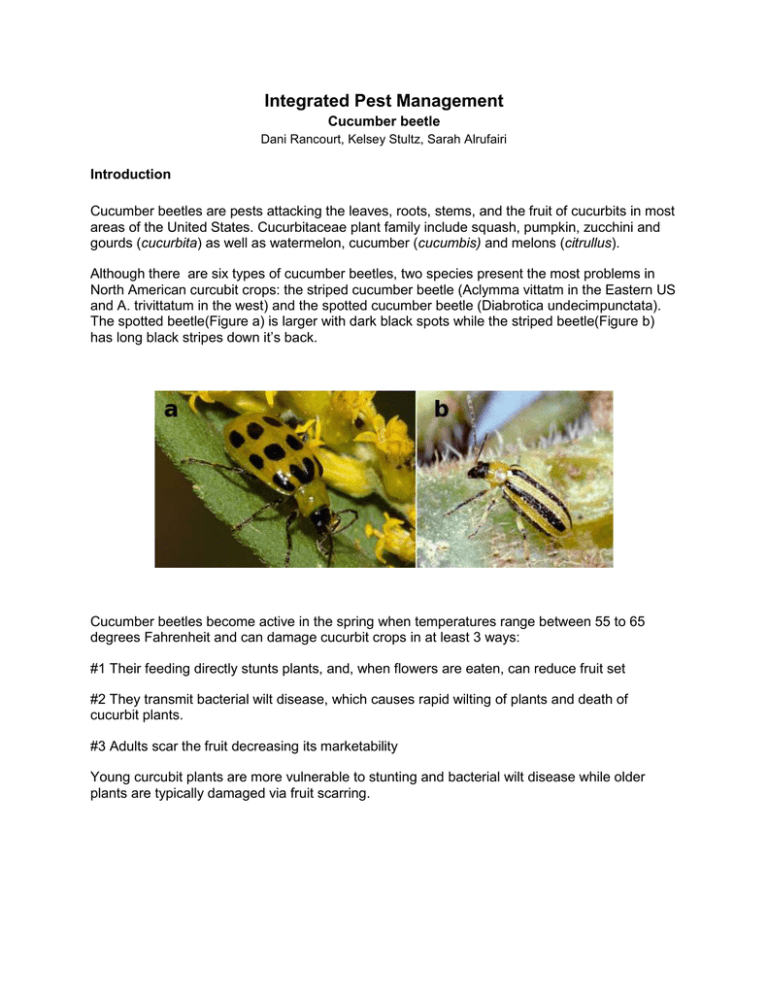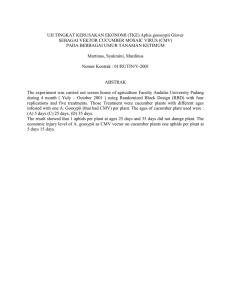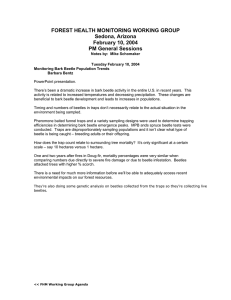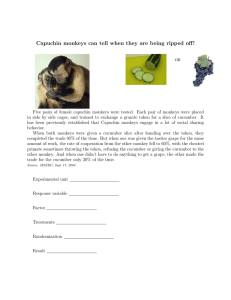Week 4 Cucumber Beetle
advertisement

Integrated Pest Management Cucumber beetle Dani Rancourt, Kelsey Stultz, Sarah Alrufairi Introduction Cucumber beetles are pests attacking the leaves, roots, stems, and the fruit of cucurbits in most areas of the United States. Cucurbitaceae plant family include squash, pumpkin, zucchini and gourds (cucurbita) as well as watermelon, cucumber (cucumbis) and melons (citrullus). Although there are six types of cucumber beetles, two species present the most problems in North American curcubit crops: the striped cucumber beetle (Aclymma vittatm in the Eastern US and A. trivittatum in the west) and the spotted cucumber beetle (Diabrotica undecimpunctata). The spotted beetle(Figure a) is larger with dark black spots while the striped beetle(Figure b) has long black stripes down it’s back. Cucumber beetles become active in the spring when temperatures range between 55 to 65 degrees Fahrenheit and can damage cucurbit crops in at least 3 ways: #1 Their feeding directly stunts plants, and, when flowers are eaten, can reduce fruit set #2 They transmit bacterial wilt disease, which causes rapid wilting of plants and death of cucurbit plants. #3 Adults scar the fruit decreasing its marketability Young curcubit plants are more vulnerable to stunting and bacterial wilt disease while older plants are typically damaged via fruit scarring. Integrated Pest Management Plan Organic Pesticide Options: ● Kaolin Clay: The gumminess of the clay is very unappealing to cucumber beetles. Kaolin clay will stick to the beetle's’ antennae and cause irritation. ● Pyrethrum: This broad spectrum insecticide is extracted from dried flower heads of African chrysanthemums. Pyrethrum should be used cautiously because it will harm both pests as well as insects that benefit crops. Application: Kaolin Clay: Surround WP (OMRI Listed) Highly recommended for apples, wine grapes, citrus, pears, walnuts, cucumbers and tomatoes. Using a backpack sprayer: 1. Mix 1/4 to 1/2 lb (approximately 3 cups) of Surround WP per one gallon of water. If your sprayer is not easy to shake, premix in a container and pour the mixture into your sprayer 2. Add the powder slowly to approximately 1/4 of the water you will be using, stir and mix well by shaking vigorously for 30 seconds. 3. Add the remaining water and shake for an additional 30 seconds. 4. Shake the sprayer occasionally during application. 5. When finished, spray until the sprayer is empty and flush the system. Leftover mix can be used within 2 weeks to avoid spoilage. Rinse the sprayer before the next batch. Note: Apple Kaolin clay, especially to leaf undersides. Reapply after rain. Pyrethrum: Clarke® Merus™ 2.0 Pyrethrum or MERUS™ Pyrethrum (OMRI Listed) May be used as a pest lure, repellent, or as part of a trap, or as a disease control. Directions: Merus 2.0 cannot be diluted with water. The solution may diluted with light mineral oil. Directions provided on packaging from Merus 2.0 should be strictly followed. Spray Cucurbitaceae family plants when adult cucumber beetles are seen feeding on pollen in flowers. Sources: Retrieved June 24, 2015, from http://msmvcd.s3.amazonaws.com/merus2.0label_0.pdf Retrieved June 24, 2015, from http://www.arbico-organics.com/product/surround-wpcrop-protectant-omri-listed-kaolin-clay/organic-insecticides Retrieved June 24, 2015, from http://www.extension.org/pages/64274/managingcucumber-beetles-in-organic-farming-systems#.VYrObKa04fr Retrieved June 24, 2015, from http://www.omri.org/sites/default/files/app_materials/15Addendum13GML1F.pdf




